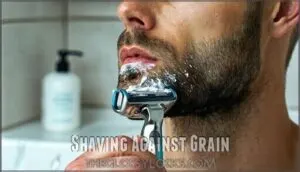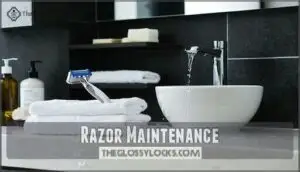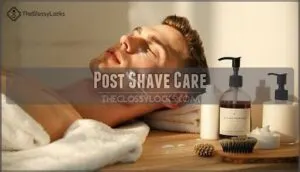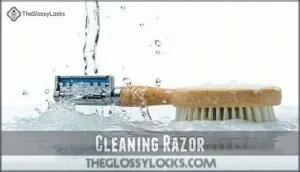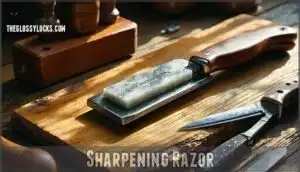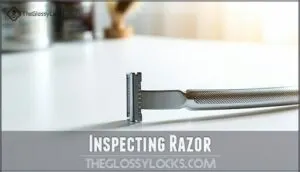This site is supported by our readers. We may earn a commission, at no cost to you, if you purchase through links.
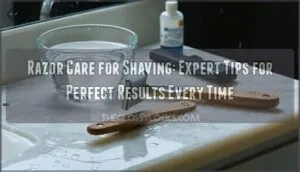 Proper razor care for shaving starts with rinsing your blade after each stroke to prevent clog buildup.
Proper razor care for shaving starts with rinsing your blade after each stroke to prevent clog buildup.
You’ll want to soak it in rubbing alcohol weekly to kill bacteria, then gently brush away stubborn debris with an old toothbrush.
Always dry your razor completely and store it in a protective case or stand to prevent nicks and rust.
Replace cartridge blades every 5-7 shaves or when they start tugging at your hair, and think of your razor like a trusty kitchen knife – treat it well, and it’ll serve you faithfully.
The difference between a well-maintained razor and a neglected one becomes crystal clear once you master these fundamentals of razor care.
Table Of Contents
- Key Takeaways
- Pre Shave Preparation
- Shaving Techniques
- Post Shave Care
- Razor Maintenance Tips
- Advanced Razor Care
- Frequently Asked Questions (FAQs)
- How do you shave a straight razor?
- How do you store a straight razor?
- How do you sharpen a straight razor?
- How do you prepare for a shave?
- Can a straight razor be resharpened?
- How to choose a good Shaver?
- How to care for your razor after shaving?
- How to stop razor rash when shaving?
- How to make your razors last longer?
- Is it better to shave wet or dry with a razor?
- Conclusion
Key Takeaways
- You’ll extend your razor’s lifespan dramatically by rinsing it thoroughly after each stroke, drying it completely, and storing it in a protective case or stand to prevent rust and damage.
- You’ll achieve smoother shaves by preparing your skin properly with warm water, exfoliation, and quality shaving cream before the blade touches your face.
- You’ll prevent razor burn and ingrown hairs by shaving with the grain first, maintaining a 30-degree angle, and using minimal pressure while letting the razor’s weight do the work.
- You’ll maintain optimal razor performance by replacing cartridge blades every 5-7 shaves, cleaning with rubbing alcohol weekly, and applying post-shave moisturizer to protect your freshly exposed skin.
Pre Shave Preparation
You’ll get the best shave of your life when you properly prep your skin before the razor touches it.
Think of pre-shave preparation as laying the foundation for a smooth, comfortable shave that won’t leave you looking like you wrestled with a cheese grater.
Your razor deserves the same care you’d give a prized kitchen knife—treat it right, and it’ll reward you with years of effortless shaves.
Exfoliating Skin
Before shaving, gentle exfoliation removes dead skin cells that can clog your razor and cause irritation.
Use a loofah or soft scrub in circular motions to smooth skin and clear pores.
This simple step prevents ingrown hairs and guarantees your blade glides effortlessly, think of it as clearing the runway for takeoff.
Applying Shaving Cream
After exfoliating, it’s time to prep your canvas.
Apply shaving cream generously across damp skin, creating a rich lather that acts like armor for your face.
Quality shaving products soften whiskers while providing essential razor glide.
Don’t skimp—proper cream application prevents that sandpaper sensation and turns your morning routine into smooth sailing.
Using Preshave Oil
Think of preshave oil as your razor’s best friend—it creates a protective barrier that transforms rough shaving into smooth sailing.
Apply a few drops to damp skin before your shaving cream, massaging gently to enhance razor glide and boost shave comfort.
Different oil types offer unique skin prep benefits, making this simple step essential for professional results.
Softening Stubble
Hot towel compresses work like magic for stubble softeners, opening hair follicles and making tough whiskers pliable.
Hot towel magic transforms stubborn whiskers into butter-smooth shaving perfection.
Apply a warm compress for two minutes before your shave—this skin preparation step transforms coarse hair into manageable strands.
Proper exfoliation methods combined with effective shaving techniques guarantee your razor maintenance efforts pay off with smoother results.
Effective pre shave preparation is vital for achieving the best shaving outcomes with proper exfoliation.
Shaving Techniques
Proper shaving technique transforms your daily routine from a chore into a comfortable, effective experience.
You’ll achieve better results while protecting your skin when you understand the fundamentals of grain direction, razor maintenance, and irritation prevention.
Shaving With Grain
Follow grain direction like following a river’s current—it’s the path of least resistance.
Identify hair growth by running fingertips across stubble; smooth indicates correct shaving direction.
Maintain a 30-degree razor angle, letting the blade’s weight guide gentle strokes.
This technique reduces irritation by 70% while preventing ingrown hairs through proper skin preparation and razor glide optimization.
To achieve ideal results, understanding shaving with grain is essential for minimizing skin irritation and ingrown hairs, and it is the key to proper shaving.
Shaving Against Grain
Shaving against the grain delivers the closest possible shave, but it’s like walking a tightrope—one wrong move increases your risk of skin irritation and ingrown hairs.
Master the proper razor angle and cutting depth to minimize problems:
- Only shave against grain direction after completing a with-the-grain pass first
- Maintain light pressure and proper razor angle to prevent excessive cutting depth
- Use a sharp razor—dull blades require more pressure and cause irritation
- Skip this technique on sensitive areas prone to razor bumps
To achieve ideal results, understanding proper shaving techniques is essential for a smooth finish.
Razor Maintenance
Your razor’s performance hinges on proper maintenance between shaves.
Rinse blades thoroughly after each use to prevent hair and soap buildup, which dulls cutting edges faster than a Monday morning alarm clock.
Store your razor in a dry location away from humid bathroom conditions to prevent rust formation.
Regular razor cleaning is vital for preventing razor hygiene issues that can lead to poor shaving results.
| Maintenance Task | Frequency | Purpose |
|---|---|---|
| Razor Cleaning | After each use | Remove debris, prevent buildup |
| Blade Sharpening | Every 5-7 shaves | Restore cutting edge |
| Rust Prevention | Weekly inspection | Extend razor lifespan |
| Edge Maintenance | Before each shave | Guarantee smooth cutting |
| Razor Storage | Daily | Promote air circulation |
To ensure the longevity and effectiveness of your razor, it is crucial to follow these maintenance tasks, including razor cleaning, blade sharpening, and rust prevention, which are essential for a smooth shaving experience.
Avoiding Irritation
Proper technique prevents most shaving irritation.
Use a sharp blade and minimal pressure—let the razor do the work.
Rinse frequently to prevent clogging, which causes tugging.
Apply quality shaving cream for skin soothing and razor glide.
Those with sensitive skin should avoid multiple passes and choose products designed for irritation prevention to minimize razor bumps and ingrown hairs.
Post Shave Care
Your skin becomes vulnerable after shaving, making proper post-shave care essential for preventing irritation and maintaining healthy skin.
Following the right steps immediately after shaving protects your freshly exposed skin and reduces your risk of razor burn, ingrown hairs, and sun damage.
Applying Moisturizer
Every quality moisturizer works like a protective shield after shaving, rehydrating your freshly exposed skin and supporting natural recovery processes.
Your skin loses essential oils during shaving, making immediate hydration vital for preventing irritation and maintaining healthy moisture levels.
- Choose alcohol-free moisturizers – They won’t sting your sensitive post-shave skin
- Apply within minutes – Lock in hydration while your pores are still receptive
- Use upward motions – Gentle application prevents additional skin irritation
- Select ingredients wisely – Look for aloe vera, ceramides, or hyaluronic acid for ideal skin recovery
Sun Protection
Vulnerability peaks after shaving when your skin’s protective barrier weakens.
Fresh razor work strips natural oils, leaving tissue exposed to UV damage and increasing skin sensitivity to sun by up to 40%. You’ll need broad-spectrum sunscreen with SPF 30+ for burn prevention and skin cancer protection.
| Sunscreen Types | UV Protection Level | Best For Post-Shave |
|---|---|---|
| Chemical Sunscreens | SPF 15-50+ | Sensitive areas |
| Mineral Sunscreens | SPF 30-50+ | Immediate protection |
| Broad-Spectrum | UVA/UVB coverage | Complete skin damage prevention |
| Water-Resistant | 40-80 minutes | Active outdoor use |
Hydrating Skin
Your freshly shaved skin craves moisture like a desert craves rain. Shaving strips away natural oils, leaving your face vulnerable to dryness and irritation.
Smart skin care starts with proper hydration tips.
- Apply moisturizer immediately after shaving while skin remains damp
- Choose alcohol-free after shave products to prevent further drying
- Use gentle, fragrance-free moisturizers designed for sensitive skin
- Reapply throughout the day for maximum skin moisture retention
Reducing Inflammation
Skin soothing after shaving prevents razor burn and inflammation relief for sensitive skin.
Anti-irritation strategies reduce discomfort and promote healing. Here’s your post-shave inflammation roadmap:
| Technique | Benefit |
|---|---|
| Cold water rinse | Closes pores, reduces swelling |
| Aloe vera gel | Natural anti-inflammatory properties |
| Witch hazel toner | Minimizes skin irritation quickly |
| Fragrance-free moisturizer | Prevents dryness, soothes sensitivity |
| Avoid alcohol-based products | Reduces burning sensation risk |
Smart shaving safety means treating your skin like a healing patient—gentle care prevents ingrown hairs and skin sensitivity issues.
Razor Maintenance Tips
Your razor’s condition directly affects your shave quality and skin health. Proper maintenance keeps blades sharp longer while preventing irritation and razor burn that comes from dull, dirty equipment.
Storing Razor
Proper razor storage protects your investment and extends blade life substantially.
Store your razor upright in a stand or protective case to promote airflow and prevent moisture buildup. Keep it in a cool, dry location outside humid bathrooms.
Apply blade oiling before extended storage to prevent corrosion. These razor storage techniques guarantee the best performance.
Using the right razor storage solutions can further enhance razor longevity.
Cleaning Razor
Beyond proper storage, maintaining razor hygiene requires regular cleaning to prevent bacterial buildup and extend blade life.
You’ll want to rinse your razor thoroughly before, during, and after each shave to remove hair and debris.
For deeper razor cleaning, soak the head in diluted white vinegar monthly to dissolve mineral deposits.
Regular use of a Razor Cleaner can also help maintain razor hygiene.
Follow these daily maintenance steps for ideal razor care:
- Rinse completely – Flush away soap residue and hair clippings
- Brush gently – Use soft bristles with mild dish soap weekly
- Dry thoroughly – Pat with a clean towel for rust prevention
- Avoid tapping – Never bang on hard surfaces to prevent damage
Proper razor sanitizing involves soaking components in rubbing alcohol periodically, especially in humid climates where bacteria thrive.
Sharpening Razor
Razor sharpening transforms dull blades into precision instruments through careful honing and stropping techniques.
Start blade sharpening every 3-7 shaves using 4,000-12,000 grit stones for edge refining. Maintain consistent angles during razor honing, then follow with strop technique using 50-100 passes.
This razor restoration process extends blade life substantially while ensuring peak performance. Regular razor maintenance involves understanding the importance of sharp blade benefits to achieve the best shaving results.
Inspecting Razor
Weekly razor inspection prevents nicks and extends blade life.
Check blade edges for dullness or damage, examine handles for loose parts, and verify smooth mechanical operation. Your razor’s condition directly impacts shaving safety and performance.
Regular razor inspection involves understanding proper Razor Inspection techniques.
Essential inspection checklist:
- Edge examination – Look for chips, rust, or mineral buildup that compromises cutting ability
- Handle care – Test moving parts and check for cracks that could cause injury
- Blade check – Assess sharpness through gentle finger tests and visual rust prevention screening
Advanced Razor Care
Once you’ve mastered basic maintenance, advanced razor care takes your shaving experience to professional levels.
These techniques require more time and skill, but they’ll keep your razor performing like new for years.
Honing Razor Blade
Maintaining razor blade sharpness requires proper honing techniques and stone selection.
You’ll restore blade geometry using progressive grits from 1,000 to 12,000, ensuring both spine and edge contact the lubricated stone throughout each stroke.
| Grit Range | Purpose | Frequency |
|---|---|---|
| 1,000-4,000 | Bevel setting, repair | As needed |
| 4,000-8,000 | Edge refining | 2-4 times yearly |
| 8,000-12,000 | Final polishing | After coarser grits |
Always flip over the spine, never the edge, to prevent damage during honing sessions.
Stropping Razor
Why settle for guesswork when razor stropping delivers precision?
Daily stropping realigns your blade’s edge without removing metal like honing does. Use quality leather strop materials and apply light pressure—twenty to fifty strokes before each shave keeps your razor sharp.
Maintain steady tension and consistent angle for ideal blade alignment and extended durability between professional sharpenings.
Proper razor maintenance involves understanding ingrown hair prevention techniques to achieve the best results, including ingrown hair prevention and maintaining your razor for extended durability with the right blade alignment.
Sanitizing Razor
After stropping maintains your blade’s alignment, proper sanitization prevents bacterial buildup that can cause infections.
Wet razor handles harbor millions of bacteria, including dangerous strains like Staphylococci.
Here’s your sanitizing protocol:
- Disassemble razor completely before cleaning
- Rinse parts under warm water thoroughly
- Soak in rubbing alcohol for 10 minutes
- Brush gently with soft-bristle toothbrush if needed
- Dry completely to prevent rust formation
Long Term Storage
When you’re not shaving regularly, proper longterm storage becomes your razor’s best friend.
Apply a thin coat of blade oil before tucking your razor into dry storage like leather cases or wooden boxes.
These razor cases protect against moisture that causes rust, while storage tips emphasize avoiding humid bathrooms.
Smart razor preservation means checking monthly for corrosion and maintaining moisture control through proper razor upkeep techniques.
Frequently Asked Questions (FAQs)
How do you shave a straight razor?
Unlike a cartridge razor’s forgiving design, straight razors demand respect and technique.
Hold the razor at a 30-degree angle, stretch your skin taut, and glide with short, controlled strokes following hair growth direction for safety.
How do you store a straight razor?
Store your straight razor in a dry location using a leather pouch or wooden box.
Apply blade oil before storage to prevent rust.
Keep it away from humid areas like bathrooms to maintain sharpness and longevity.
How do you sharpen a straight razor?
Professional sharpeners maintain that 90% of straight razor issues stem from improper honing technique.
You’ll sharpen your blade using whetstones at consistent 30-degree angles, starting with 4,000-grit stones for repairs and finishing with 8,000-12,000 grit for polishing—it’s like giving your razor a spa treatment.
How do you prepare for a shave?
Start by washing your face with warm water and gentle cleanser to remove oils. Exfoliate gently, then apply shaving cream to soften hair and protect skin for smooth razor glide.
Can a straight razor be resharpened?
Yes, you can definitely resharpen straight razors through stropping and honing. You’ll strop daily before each shave, then hone every few months using whetstones at proper angles for lasting sharpness.
How to choose a good Shaver?
Choose a shaver based on your hair type, skin sensitivity, and shaving frequency.
Electric shavers work well for daily use and sensitive skin, while manual razors provide closer shaves but require more technique and care, including the need to consider skin sensitivity.
How to care for your razor after shaving?
Rinse your razor with warm water after each shave, then dry it completely with a clean towel. Store it in a dry place to prevent rust and bacterial growth.
How to stop razor rash when shaving?
Razor burn feels like fire on your skin, but you can douse those flames.
Use pre-shave oil, shave with the grain, apply cold water after, and moisturize immediately to prevent irritation.
How to make your razors last longer?
Store your razor in a dry place after each use and rinse thoroughly during shaving.
Replace blades every 5-10 shaves, strop daily, and apply blade oil monthly to prevent rust and maintain sharpness effectively.
Is it better to shave wet or dry with a razor?
Think of dry skin as sandpaper against steel – it’ll dull your blade fast.
You should always wet shave with warm water and quality shaving cream.
This softens whiskers, protects skin, and helps your razor glide smoothly without tugging or irritation.
Conclusion
Mastering razor care for shaving transforms your daily routine from a chore into a ritual of precision.
You’ve learned the essential steps—proper pre-shave preparation, correct techniques, thorough maintenance, and post-shave care.
Remember, your razor deserves the same attention you’d give any valuable tool.
Clean it after each use, store it properly, and replace blades when they dull.
These habits prevent irritation, extend blade life, and deliver consistently smooth results that’ll make every shave feel effortless, contributing to a daily routine that becomes a valuable tool.
- https://estrid.com/blogs/shaving-tricks/guide-to-keeping-your-razor-clean
- https://www.therazorcompany.com/blogs/the-benefits-of-wet-shaving/razor-blade-care-101-how-to-extend-the-life-of-your-blades
- https://cremocompany.com/blogs/blog/how-to-clean-your-safety-razor
- https://www.wilkinsonsword.com/blogs/mens/how-to-clean-a-razor-head-and-razor-blades
- https://www.aad.org/public/everyday-care/skin-care-basics/hair/how-to-shave


